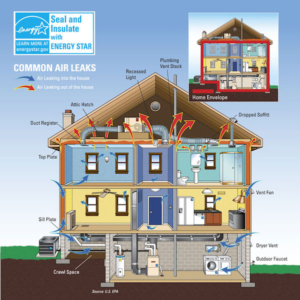If you have floors, outlets or walls that feel cold to the touch, you likely have cold air leaks.
BC winters are notoriously damp and chilly. We may not get a whole lot of snow, but cooler temperatures, wind and plenty of rain can leave you feeling chilled to the bone. This is especially true if your home is experiencing cold air leaks and insulation trouble.
If you’re noticing that your home is having a difficult time retaining heat and you can feel a draft simply by putting your hand up to an outlet, window or door frame, it’s time to take a good look around for cold air leaks.
What Exactly Are Cold Air Leaks?
Cold air leaks are energy vampires, letting outside air in through any gaps or openings in your home. This cold air makes it tough to keep your home at a comfortable temperature and can result in wasted energy and higher heating costs.
Where Can Cold Air Leaks Be Found?
Cold air can easily seep into your home through cracks and gaps around door and window frames and any openings to the outside. Now, most basements will be colder simply because warm air rises, but there shouldn’t be an extreme temperature difference between floors. Common culprits of cold air leaks include:

- Attic hatches
- Dryer vents
- Kitchen fan vents
- Open soffits
- Holes for wiring
- Holes for plumbing fixtures
- Recessed light fixtures
- Ductwork and the duct chaseway (where the duct is kept hidden behind the wall)
How to Locate Cold Air Leaks
Looking at the list above, you probably have a few suspect areas throughout your home. Go with your gut (it’s usually right!) and start with those areas. Drafts from under and around door frames are very common. Any cracked caulking or weatherstripping is also a fairly good clue that a little extra TLC is needed to improve your home’s energy efficiency. Energystar.gov has an excellent diagram to give you a visual image of where cold air leaks may be.
The Paper Test
This one is especially useful for suspect door and window leaks. All you need is a piece of paper. Put a piece of regular paper in your window/door frames and close it. If you can pull the piece of paper out without it tearing, this indicates an air leak. Since our homes have many doors and windows, make sure to record which windows and doors have leaks, so there’s no guessing game later.
The Light Test
This one takes two people, one to stay inside the home and one to go outside. Using a flashlight, the person inside the home will shine the light over all the possible gaps. This is best done at night, working your way through the whole house from top to bottom. Using the blueprints for your home or even just the diagram linked above, mark any areas where light shone through to the outside. These are areas that will need additional sealing.
Ultrasonic Air Detection
Use an ultrasonic air detector to do the work for you. These use ultrasound technology to detect air leaks, so all you have to do is turn it on and point it at any suspect areas. What’s really cool is that it will be able to detect if the leaking air is cool or warm. For best results, we recommend calling in an HVAC technician with a commercial quality ultrasonic detector. At Lockhart Industries we’ll do the work for you. Our team specializes in all things HVAC, ensuring that your home is as comfortable as possible.
How to Fix Cold Air Leaks?
As winter sets in, you’re going to thank yourself for taking some time to seal up those drafty areas. BC Hydro has some excellent DIY tricks for fixing drafts:
- Attic hatches – Warm, humid air that meets cold air up in the attic can result in mildew and mold over time, even leading to structural rot. It’s relatively simply to add insulation to your attic hatch. There’s a great DIY here.
- Dryer vents, Kitchen fan vents, and ductwork – Use spray foam insulation or caulking to thoroughly seal any gaps where the venting and ductwork enters and exits. Use duct tape or aluminum tape on the joints of the ductwork.
- Open soffits and recessed light fixtures – Take the light down and use duct tape or spray foam to seal up any gaps between the ceiling and the housing for the light.
- Bathroom fans – Like dryer vents and kitchen fan vents, use spray foam insulation or caulking. In a pinch, you can seal any gaps between the housing and the ceiling with duct tape or aluminum tape.
- Holes for wiring and plumbing – Use spray foam or caulking to fill the spaces where wiring and plumbing enters and exits.
- Outlets and switches – Grab some pre-cut foam pads/gaskets from your local hardware store. *Turn the power off to the outlet first. Then, unscrew the outlet cover and line up the pad with the socket holes. Replace the outlet cover and turn the power back on.
- Windows – Even with double-paned windows, it can get drafty. Use plastic film on top of the glass to create another layer of insulation.
- Door frames and window frames – Take a few hours out of your weekend to identify and seal any offending windows and doors. A few options:
- If you can’t remove the trim, press rope caulk into the gaps. Rope caulk has a putty-like texture that seals gaps and seams effectively. You can also use regular caulk, but for windows, we recommend the more pliable rope caulk.
- If you can remove the trim, use a spray foam (non-expanding) to fill the gaps.
- For moving parts, weatherstripping is invaluable. Door sweeps are a great long-lasting option that fill the space between the bottom of the door and the flooring. Read more about your weatherstripping options from This Old House here.
You can also take a look at this video by This Old House that shows how to stop air leaks. This handy video covers how to stop cold air from coming into your home through everything from windows and doors to outlets and openings for plumbing fixtures.
If you need help with discovering and stopping leaks, our team at Lockhart Industries can help.
We’re experts at designing and providing residential and commercial buildings with the most efficient and convenient heating and cooling solutions on the market. Island owned and operated for over 35 years, we’re trusted by many happy customers from Duncan to Victoria, BC. If you’re ready to improve your home’s heat and energy efficiency for year-round comfort, contact us today.
Easy Financing with…
Start Saving Money NOW! There’s no need to putting off a more Energy Efficient, Cost Effective home comfort system. We make it simple!
With Financeit you can:
- Make additional payments any time without penalty.
- Get a lower payment by choosing an amortization period of up to 180 months. 7.99% to 11.99% interest rate.*
- We add a small fee to the loan amount. There are no hidden or additional charges
- Bank-level encryption (AES-256 bit SSL) to protect your personal information.



